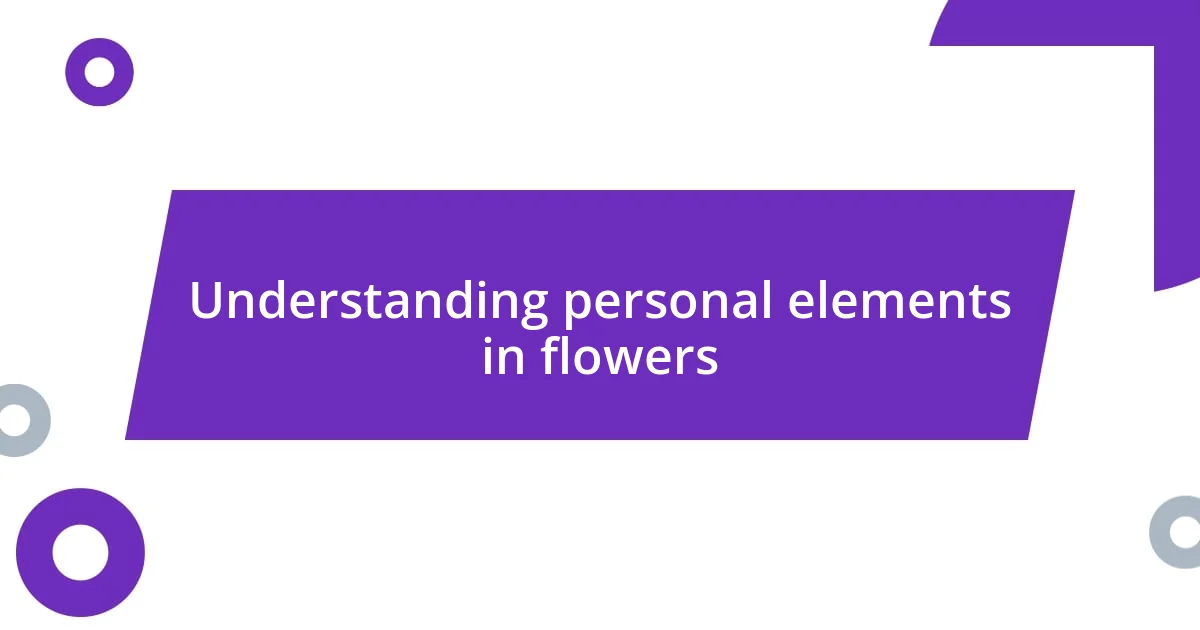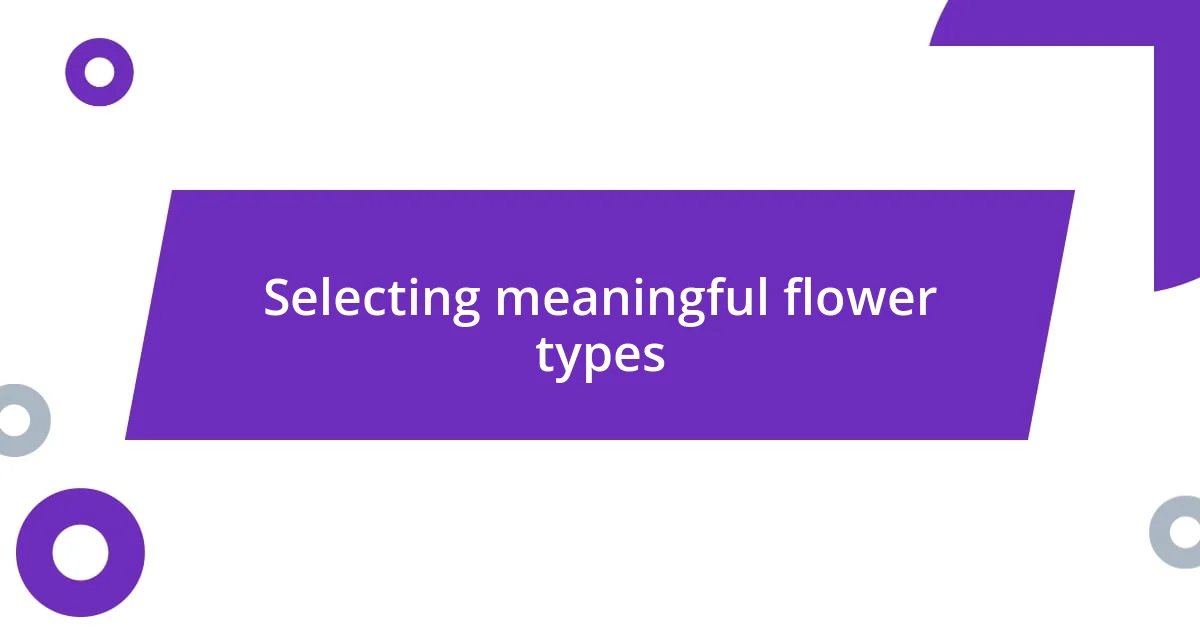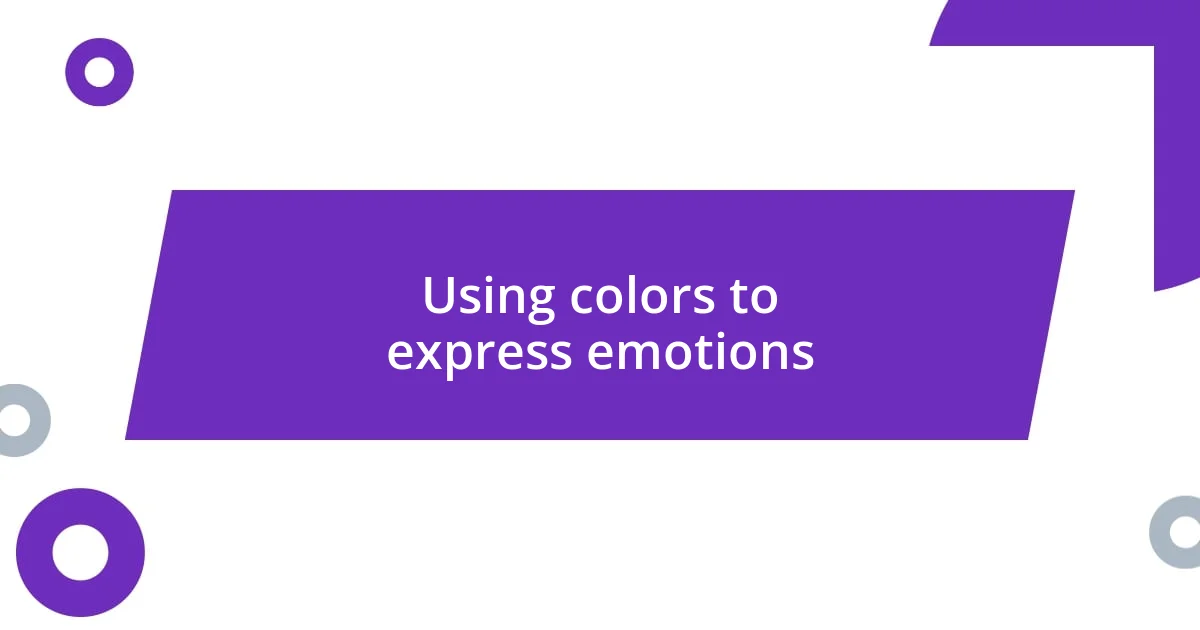Key takeaways:
- Flowers carry personal meanings and evoke emotions, enhancing connections to cherished memories and experiences.
- Selecting meaningful flower types and colors can deepen the emotional layers of arrangements, reflecting significant relationships and events.
- Floral displays serve as storytelling canvases, sparking shared memories and narratives that connect people through emotional experiences.

Understanding personal elements in flowers
Flowers are more than just beautiful creations of nature; they often carry deep personal meanings and emotions. I still remember crafting a bouquet for my grandmother’s 80th birthday, using her favorite lilacs and daisies. Each flower represented a cherished memory, and that connection made the moment feel profoundly special.
Have you ever considered why certain flowers resonate with you? For me, sunflowers remind me of childhood summer days spent playing in the garden. The bright petals and towering stalks carry not just a visual appeal but a flood of nostalgia, reflecting how personal elements can shape our emotional ties to flowers.
Understanding personal elements in flowers requires looking beyond their aesthetic value. It’s about exploring how they evoke feelings, memories, and connections with people and places. For instance, when I see a red rose, it takes me back to my first date. The emotions tied to such experiences inform our perception of flowers, turning them into symbols of our life stories.

Selecting meaningful flower types
When selecting flowers, the type you choose can significantly enhance the personal meaning behind your arrangement. For instance, I often opt for peonies when celebrating a friend’s achievements. Their lush, full blooms not only symbolize prosperity but also remind me of the joy and support we’ve shared during tough times. It’s fascinating how a flower can encapsulate years of friendship in its delicate petals.
- Consider personal connections: Choose flowers tied to specific memories or relationships.
- Research meanings: Look into floral symbolism to find how certain flowers represent feelings or attributes.
- Reflect on your experiences: Think about events or moments where specific flowers played a role; it adds a layer of personal significance.
- Embrace seasonal blooms: Select flowers that reflect other meaningful times, like weddings or family gatherings, enhancing your bond to the moment.
Ultimately, selecting meaningful flowers deepens the emotional layers of any bouquet, making your gift or arrangement all the more special.

Designing innovative flower arrangements
Designing innovative flower arrangements allows us to infuse personality and emotion into our creations. I remember working on a project for a close friend’s wedding where I incorporated her family’s favorite colors along with flowers that had deep-rooted significance to her. By nesting lavender and hydrangeas in shades of blue, I crafted an arrangement that resonated with her family history and their love for each other. This made the floral display not just vibrant but a lasting emblem of their bond.
When I think about innovative design, it’s not just about aesthetics; it’s about storytelling. For example, I often experiment by mixing traditional blooms with unexpected elements like dried foliage or seasonal fruits. I recall one arrangement where I used oranges alongside elegant white roses, creating a refreshing burst of color. That arrangement not only spoke to the season but also reminded me of my grandmother’s citrus grove, blending delightful childhood memories with modern design.
You might ask, how can you make your arrangements stand out and convey personal stories? One effective approach is layering textures and heights. I’ve found that combining delicate flowers like wax flowers with bold sunflowers creates an inviting visual contrast. This method not only adds dimension but also reflects the complex beauty of personal relationships, each layer telling a different part of our shared experiences.
| Traditional Arrangements | Innovative Designs |
|---|---|
| Focus on symmetry and classic color schemes | Emphasize asymmetry and playful color combinations |
| Common flower choices like roses and lilies | Incorporate unique elements like dried foliage or fruits |
| Often reflect expected meanings | Tell personal stories through flower selection and arrangement |

Using colors to express emotions
When it comes to colors in floral arrangements, each hue resonates with specific emotions. For instance, vibrant reds evoke passion and love, while soft blues can inspire tranquility. I once created a bouquet for a friend recovering from a loss, and I chose yellows and whites. The bright colors reflected hope and renewal, brightening not just her space but her spirit, too.
What’s truly intriguing is how personal experiences can shape our emotional responses to color. I remember crafting a centerpiece for a family gathering that featured rich purples and soft pinks, drawing from a cherished memory of my late mother’s garden. Each time I see those colors, I feel her warmth and presence, illustrating the profound connection between color and emotion in personal storytelling.
Exploring the world of floral colors can lead you to discover your emotional palette. Have you ever noticed how certain colors can trigger specific memories or feelings? For me, it’s the bright oranges of marigolds that remind me of summer afternoons spent with friends. By thoughtfully choosing colors that resonate personally, you can create arrangements that are more than decorative pieces; they become vivid expressions of our life’s tapestry.

Sharing stories through floral displays
Floral displays are more than just visual feasts; they tell stories. For instance, I once created a centerpiece for a charity gala that celebrated local artists. I handpicked flowers that each represented a different artist’s journey, like sunflowers for resilience and delicate peonies for beauty. When the guests saw the arrangement, many started sharing their own stories related to those flowers, igniting conversations that connected strangers through shared emotions and experiences.
Have you ever noticed how a certain flower can spark a memory? I designed a bouquet featuring daisies and bluebells for my niece’s graduation, colors that matched her favorite childhood dress. As she held it, tears filled her eyes, and she shared how those flowers reminded her of carefree summers spent in the garden with her grandmother. In that moment, the floral display became more than a celebration of achievement; it embodied a bridge between her past and future, illustrating how flowers can evoke powerful narratives.
Every arrangement can serve as a canvas for storytelling. I remember creating a wedding arch that intertwined roses, ivy, and wildflowers, each element reflecting the couple’s unique love story. The roses represented their enduring love, while the wildflowers symbolized the spontaneity of their adventure together. When guests gathered beneath that arch, they weren’t just witnessing a wedding; they were stepping into a personal story that would linger in their hearts long after the flowers faded. Isn’t it wonderful how something as simple as a flower can carry so much meaning?














